
An increasing percentage of our readers have been building systems for use next to a high definition television set, inside compact cases. Our review product today – the Asus GTX 970 DC Mini is designed for just such a scenario. This diminutive solution is just 170mm long and will fit inside the smallest cases available on the market today.

Above, the Asus GeForce GTX 970 DirectCU Mini is pictured installed on the Asus Maximus VII Impact motherboard. This is a fabulous little mITX motherboard, which we reviewed back in December 2014. You can read our full analysis if you missed it, over HERE.
| GPU | GeForce GTX 750ti (Maxwell) | GeForce GTX 960 (Maxwell) | Geforce GTX 970 (Maxwell) | GeForce GTX 980 (Maxwell) |
| Streaming Multiprocessors | 5 | 8 | 13 | 16 |
| CUDA Cores | 640 | 1024 | 1664 | 2048 |
| Base Clock | 1020 mhz | 1126 mhz | 1050 mhz | 1126 mhz |
| GPU Boost Clock | 1085 mhz | 1178 mhz | 1178 mhz | 1216 mhz |
| Total Video memory | 2GB | 2GB | 4GB | 4GB |
| Texel fill-rate | 40.8 Gigatexels/Sec | 72.1 Gigatexels/Sec | 109.2 Gigatexels/Sec | 144.1 Gigatexels/Sec |
| Memory Clock | 5400 mhz | 7010 mhz | 7000 mhz | 7000 mhz |
| Memory Bandwidth | 86.4 GB/sec | 112.16 GB/sec | 224 GB/s | 224 GB/sec |
| Bus Width | 128bit | 128bit | 256bit | 256bit |
| ROPs | 16 | 32 | 56 | 64 |
| Manufacturing Process | 28nm | 28nm | 28nm | 28nm |
| TDP | 60 watts | 120 watts | 145 watts | 165 watts |
Above, a table detailing Nvidia's latest Maxwell cards (Titan X – review forthcoming).

Above, an overview of the Asus GTX970 Direct CU Mini. Asus have enhanced the Base Clock speed from 1,050mhz to 1,089mhz. Boost clock speed is subsequently increased to 1,228mhz. The 4GB of GDDR5 memory is clocked at 1,753mhz (7Gbps effective). This memory is connected via a 256bit memory interface.
The GM204 GPU is manufactured on the 28nm process. There are 56 ROPS, 104 Texture units and 1,664 CUDA Cores.

Asus box artwork is instantly recognisable. Along the bottom of the box, are key selling points. The card is indeed overclocked, has 4GB of GDDR5 memory and is ‘perfect' for ITX systems.

The rear of the box offers more detail on the card configuration, including the adoption of concrete core chokes. This is said to eliminate buzzing sounds when under full load.

Not much of a bundle, just some literature on setting the card up.


The GTX 970 DirectCU Mini is only 17cm long, 12.19cm high and 4.07cm thick. Asus have included a backplate on the card to help improve appearance and cooling efficiency. It is quite heavy and we like the design, which is effective.


It is SLI capable, just like any GTX970 we have reviewed to date. The card takes all the power it needs from a single 8 pin connector.

The Asus GeForce GTX 970 DirectCU Mini has two DVI connectors on the back (DVI-D and DVI-I), and a full sized HDMI 2.0 and DisplayPort. This HDMI port will handle 4K resolutions at up to 60hz.

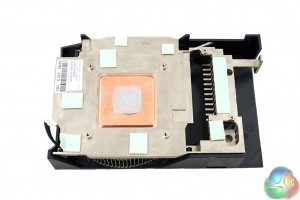
The cooler is very compact and actually uses a vapor chamber to help enhance the performance. The card is using high grade SAMSUNG memory chips – always good to see.On this page we present some high resolution images of the product taken with a Fuji XT1 and a Sigma SD1 camera. These will take much longer to open due to the dimensions, especially on slower connections. If you use these pictures on another site or publication, please credit Kitguru.net as the owner/source.




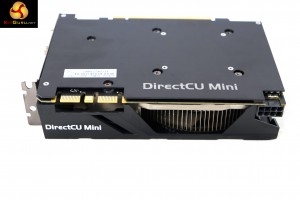







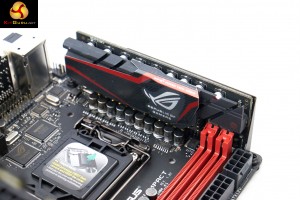

For the review today we are using Nvidia 347.88 drivers. We retested all Nvidia hardware with these drivers for this review, to keep things on a completely even footing. The AMD cards were tested with the Catalyst OMEGA 14.12 driver.
If you want to read more about our test system, or are interested in buying the same Kitguru Test Rig, check out our article with links on this page. We are using an Asus PB287Q monitor for this review today.
We test all the hardware today at high image quality settings and with anti aliasing when possible. Years ago gamers would have to make sacrifices to get smooth frame rates at 1080p – but it is 2015 and we all expect very high image quality even from these ‘mid range’ boards. We include higher cost cards such as the R9 290 and GTX770 to get an idea of performance positioning in the market.
Comparison cards:
Inno3D GTX960 iChill X3 Air Boss Ultra (1,329 mhz core / 1,800 mhz memory)
MSI GTX960 Gaming 2G OC (1,190 mhz core / 1,753 mhz memory)
Palit GTX960 Super JetStream (1,279 mhz core / 1800 mhz memory)
Asus GTX960 Strix OC Edition (1,253 mhz core / 1800 mhz memory)
Asus R9 290 Direct CU II OC (1000 mhz core / 1,260 mhz memory)
Gigabyte GTX770 OC (1,137 mhz core / 1,753 mhz memory)
Sapphire Dual X R9 285 (965 mhz core / 1,400 mhz memory)
XFX R9 280X DD (1,000 mhz core / 1,500 mhz memory)
Asus Direct CU II GTX 760 OC (1,006 mhz core / 1,502mhz memory)
Asus GTX750TI Strix OC Edition (1,124 mhz core / 1,350mhz memory)
Software:
Windows 7 Enterprise 64 bit
Unigine Heaven Benchmark
Unigine Valley Benchmark
3DMark Vantage
3DMark 11
3DMark
Fraps Professional
Steam Client
FurMark
Games:
Grid AutoSport
Tomb Raider
Metro Last Light Redux
Thief 201
Total War Rome 2: Emperor Edition
All the latest BIOS updates and drivers are used during testing. We perform generally under real world conditions, meaning KitGuru tests games across five closely matched runs and then average out the results to get an accurate median figure. If we use scripted benchmarks, they are mentioned on the relevant page.
Game descriptions edited with courtesy from Wikipedia.Futuremark released 3DMark Vantage, on April 28, 2008. It is a benchmark based upon DirectX 10, and therefore will only run under Windows Vista (Service Pack 1 is stated as a requirement) and Windows 7. This is the first edition where the feature-restricted, free of charge version could not be used any number of times. 1280×1024 resolution was used with performance settings.


The Asus GeForce GTX 970 DirectCU Mini tops our mid to high end range of cards, scoring 45,295 points.
3DMark 11 is designed for testing DirectX 11 hardware running on Windows 7 and Windows Vista the benchmark includes six all new benchmark tests that make extensive use of all the new features in DirectX 11 including tessellation, compute shaders and multi-threading. After running the tests 3DMark gives your system a score with larger numbers indicating better performance. Trusted by gamers worldwide to give accurate and unbiased results, 3DMark 11 is the best way to test DirectX 11 under game-like loads.
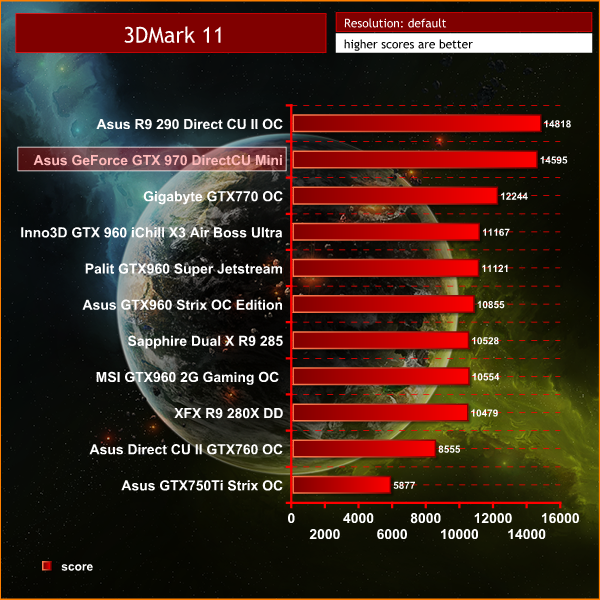

The Asus GeForce GTX 970 DirectCU Mini switches places with the Asus R9 290 Direct CU II OC in this Direct X 11 test, but it is very closely matched.
3DMark is an essential tool used by millions of gamers, hundreds of hardware review sites and many of the world’s leading manufacturers to measure PC gaming performance.
Futuremark say “Use it to test your PC’s limits and measure the impact of overclocking and tweaking your system. Search our massive results database and see how your PC compares or just admire the graphics and wonder why all PC games don’t look this good.
To get more out of your PC, put 3DMark in your PC.”

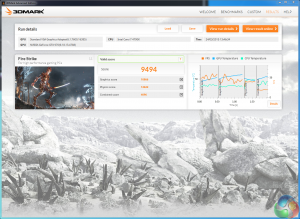
Top of the pile again again in the latest Direct X 11 benchmark, scoring 10,866 points in the graphics test.Unigine provides an interesting way to test hardware. It can be easily adapted to various projects due to its elaborated software design and flexible toolset. A lot of their customers claim that they have never seen such extremely-effective code, which is so easy to understand.
Heaven Benchmark is a DirectX 11 GPU benchmark based on advanced Unigine engine from Unigine Corp. It reveals the enchanting magic of floating islands with a tiny village hidden in the cloudy skies. Interactive mode provides emerging experience of exploring the intricate world of steampunk. Efficient and well-architected framework makes Unigine highly scalable:
- Multiple API (DirectX 9 / DirectX 10 / DirectX 11 / OpenGL) render
- Cross-platform: MS Windows (XP, Vista, Windows 7) / Linux
- Full support of 32bit and 64bit systems
- Multicore CPU support
- Little / big endian support (ready for game consoles)
- Powerful C++ API
- Comprehensive performance profiling system
- Flexible XML-based data structures

We set Quality to ‘Ultra', Tessellation to ‘Normal', Anti Aliasing to 4 times and the resolution to 1920×1080 (1080p).

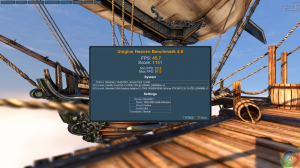
At the top of the chart, we can see the R9 290 OC battling it out against the GTX970 DirectCU Mini. The Mini just nudges out in front, by just over 2 frames per second average.Tomb Raider received much acclaim from critics, who praised the graphics, the gameplay and Camilla Luddington’s performance as Lara with many critics agreeing that the game is a solid and much needed reboot of the franchise. Much criticism went to the addition of the multiplayer which many felt was unnecessary. Tomb Raider went on to sell one million copies in forty-eight hours of its release, and has sold 3.4 million copies worldwide so far. (Wikipedia).
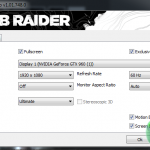


We test at both 1080p and 1440p with the ULTIMATE quality image profile enabled.


A clear win for the Asus GeForce GTX 970 DirectCU Mini, at both 1080p and 1440p resolutions.
Grid Autosport (styled as GRID Autosport) is a racing video game by Codemasters and is the sequel to 2008′s Race Driver: Grid and 2013′s Grid 2. The game was released for Microsoft Windows, PlayStation 3 and Xbox 360 on June 24, 2014. (Wikipedia).



We test at both 1080p and 1440p, with the game engines ‘ULTRA' image quality profile and with 8 times Anti Aliasing enabled.

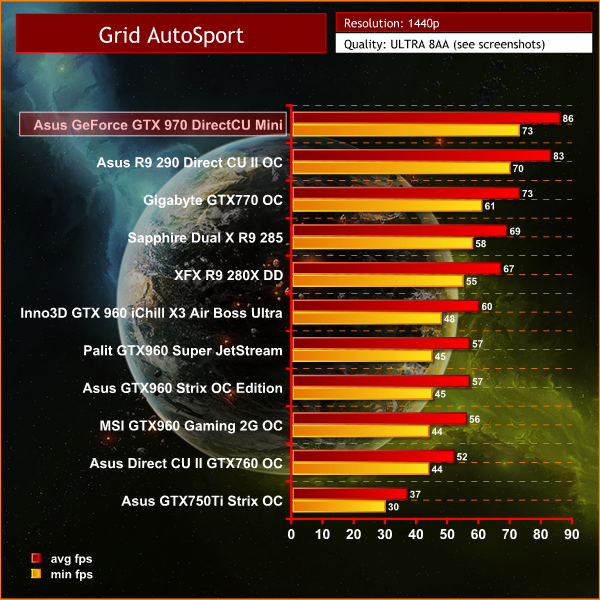
A clear lead at 1080p, averaging 108 frames per second. When the resolution is increased to 1440p, the percentage gap drops between the R9 290, averaging 86 frames per second, against 83 frames per second.
Thief is set in a dark fantasy world inspired by Victorian, gothic, and steampunk aesthetics. Garrett, a master thief who has been away from his hometown for a long time, returns to it, a place known only as The City, and finds it ruled with an iron grip by a tyrant called The Baron. While The City is ravaged by a plague, the rich continue to live in isolation and good fortune while the poor are forming numerous mobs against the authorities, Garrett intends to use the volatile situation to his favor. (Wikipedia).





At 1080p, the Asus GeForce GTX 970 DirectCU Mini has a tiny performance advantage over the R9 290 OC, this drops at 1440p, although the minimum frame rate is higher, translating into a better gaming experience.
On May 22, 2014, a Redux version of Metro Last Light was announced. It was released on August 26, 2014 in North America and August 29, 2014 in Europe for the PC, PlayStation 4 and Xbox One. Redux adds all the DLC and graphical improvements. A compilation package, titled Metro Redux, was released at the same time which includes Last Light and 2033. (Wikipedia). We test with following settings: quality high, SSAA on, 16AF, Tessellation normal.

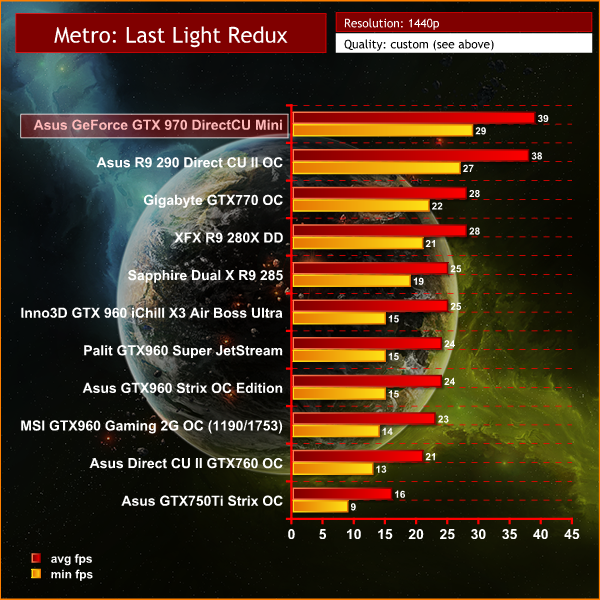
A very even match at the top with this intensive Direct X 11 engine. Overall performance at 1080p and 1440p is very strong and the game is perfectly playable at both resolutions.
Total War: ROME II Emperor Edition. Emperor Edition collects together all free content to date, which includes wide-ranging revisions, additions to game features and adds a brand new Campaign Pack expansion, ‘Imperator Augustus’.
We test the game at 1080p with the image quality settings at the maximum – ‘EXTREME'. Unless we drop image quality settings noticeably, this game needs more powerful hardware to run smoothly at 1440p.

At these settings, this engine can bring all but the most powerful graphics cards to their knees. At said, at 1080p, the performance is perfectly acceptable.
The tests were performed in a controlled air conditioned room with temperatures maintained at a constant 23c – a comfortable environment for the majority of people reading this.Idle temperatures were measured after sitting at the desktop for 30 minutes. Load measurements were acquired by playing Crysis Warhead for 30 minutes and measuring the peak temperature. We also have included Furmark results, recording maximum temperatures throughout a 30 minute stress test. All fan settings were left on automatic.


We already know Maxwell is a cool running architecture, and we see that when gaming the Asus GeForce GTX 970 DirectCU Mini runs at around 60c. The synthetic Furmark stress test pushes the card higher than any real world situation, peaking at 68c.
We install the graphics card into our system and measure temperatures on the back of the PCB with our Fluke Visual IR Thermometer/Infrared Thermal Camera. This is a real world running environment.
Details on each test are shown below.

The backplate reads just under 48c after 15 minutes of gaming.

After 10 minutes of dealing with the Furmark stress test, the backplate reads 53.4C. The backplate handles the job very well.

A hot spot appears on the card, close to the SLI connectors. This is the location where a lot of hot air escapes, as the fan is forcing the air in this direction. The temperature in this area shifted between 60c and 62c, averaging around the 61c mark.
We have built a system inside a Lian Li chassis with no case fans and have used a fanless cooler on our CPU. The motherboard is also passively cooled. This gives us a build with almost completely passive cooling and it means we can measure noise of just the graphics card inside the system when we run looped 3dMark tests.
We measure from a distance of around 1 meter from the closed chassis and 4 foot from the ground to mirror a real world situation. Ambient noise in the room measures close to the limits of our sound meter at 28dBa. Why do this? Well this means we can eliminate secondary noise pollution in the test room and concentrate on only the video card. It also brings us slightly closer to industry standards, such as DIN 45635.
KitGuru noise guide
10dBA – Normal Breathing/Rustling Leaves
20-25dBA – Whisper
30dBA – High Quality Computer fan
40dBA – A Bubbling Brook, or a Refrigerator
50dBA – Normal Conversation
60dBA – Laughter
70dBA – Vacuum Cleaner or Hairdryer
80dBA – City Traffic or a Garbage Disposal
90dBA – Motorcycle or Lawnmower
100dBA – MP3 player at maximum output
110dBA – Orchestra
120dBA – Front row rock concert/Jet Engine
130dBA – Threshold of Pain
140dBA – Military Jet takeoff/Gunshot (close range)
160dBA – Instant Perforation of eardrum

The single fan spins at around 2,000 rpm under load. It is not loud at this speed, but it is clearly audible when gaming, although the noise is likely to be masked by several case fans. I didn't find the noise intrusive, as the fan pitch was quite low.
We normally test power demand direct from the VGA card input, with our Keithley Integra unit. Today however we decided to go with a more traditional approach – measuring system wide load, minus the monitor. The system we are using for this review today is detailed HERE.

All of the Maxwell cards are efficient and the Asus GeForce GTX 970 DirectCU Mini system consumes a total of 226 watts.
We use MSI Afterburner to test overclocking capabilities of the GTX 970 DirectCU Mini.


There is surprisingly quite a lot of headroom on the core, a little over 11% in our testing. Boost speed was increased to 1,351mhz.


Pushing the core speed reaps good reward. The 3DMark 11 graphics score increases from 14,595 points to 15,696 points.
Nvidia's Maxwell hardware continues to impress me, and I still rate the GTX970 very highly even though Nvidia's reputation has been taking a hammering in recent months. I don't really want to dwell on the GTX970 memory concerns today, if you have managed to miss the reports, click this link for some background history published on KitGuru.
If you are concerned about buying a GTX970, then rest assured that under the majority of conditions you are unlikely to run into any performance related problems, especially if your main focus is 1080p and 1440p gaming.
Using that last portion of the 4GB memory is more likely at 4K resolutions, but to be honest, the hardware isn't powerful enough in the first place – you really should be looking at the GTX980, and probably in SLi. Our review of the new Nvidia Titan X is underway and this is certainly another option for 4K gaming.

The Asus GeForce GTX 970 DirectCU Mini is a fantastic product released to target a very specific audience. This tiny 17cm graphics card is an ideal partner for a motherboard such as the Asus Maximus VII Impact which we showcased a little in our review today. We analysed this particular board in some detail, late last year – if you missed the review, read our analysis HERE.
The biggest audience will be buying the Asus GTX970 Mini for use inside a space confined chassis – probably connected to a large HD television. This may be incorporated into a media center build, or just a small gaming rig fitted with an mITX motherboard. There are other options available and the Asus GTX 970 DirectCU Mini is undoubtedly one of the most powerful small form factor graphics cards on the market.
Performance at 1080p and 1440p is exemplary, outperforming the overclocked R9 290 in almost every game at both resolutions. Noise levels are kept relatively low thanks to the efficiency of the Maxwell architecture. The use of a backplate will help stability and as our thermal camera imaging shows temperatures are held well within safe parameters.

You can buy the Asus GeForce GTX 970 DirectCU Mini from Overclockers UK for £289.99 inc vat. It earns our WORTH BUYING award.
Discuss on our Facebook page, over HERE.
Pros:
- Well built.
- superb performance at 1080p.
- small dimensions will suit the smallest cases.
- plenty of headroom for additional overclocking.
Cons:
- Single fan isn't the quietest.
Kitguru says: The Asus GTX970 DirectCU Mini is a high performance solution targeting small form factor cases. It is well built and can deliver super smooth frame rates at 1080p, and even 1440p.

 KitGuru KitGuru.net – Tech News | Hardware News | Hardware Reviews | IOS | Mobile | Gaming | Graphics Cards
KitGuru KitGuru.net – Tech News | Hardware News | Hardware Reviews | IOS | Mobile | Gaming | Graphics Cards



Hmm You mean 3GB GDDR5 + 1GB DDR3 😉 New nV feature to cut down performance lol
Oh my god would you stop with that already. Jesus fucking Christ, that’s all people talk about anymore. Hop on the 3gb bandwagon. Nobody is complaining about the titan x only having a 256 bit memory bus width, with 12 Gb of VRAM, the bottleneck doesn’t get much tighter than that.
Uhm, it’s 3.5gb actually. If you’re gonna troll, at least make an effort.